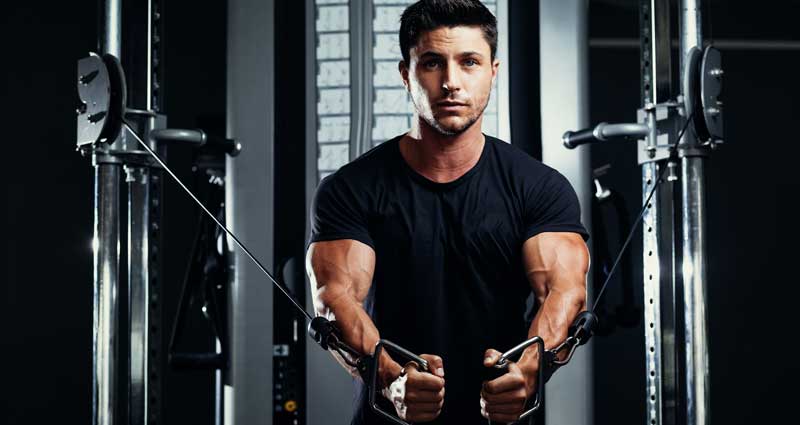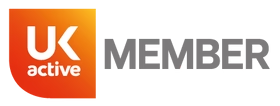A question we often get is what are the best workouts for the upper body? We thought we would ask the expert, so we caught up with Study Active Fitness Guru Chris Walsh to hear what he has to say on this.
IMPORTANT: The ideas in this article are purely for information only – please do not start an exercise programme until you have completed a PAR-Q and if necessary, received medical clearance. Always warm up and cool down and never do any exercise that you are unsure of without the support of a qualified professional.
Why is an upper body workout important?
Well, there are a few things to consider here so let me list them. An upper body workout can help with the following:
- Correct and maintain posture. It can also reduce the impact of kyphosis, round shoulders, hunched position from sitting at a desk too long.
- Build muscle to support joints and aid movement making the activities of daily living easier. i.e., lifting the shopping or making the bed, gardening etc.
- Increase athleticism, improving one’s ability at any chosen sport or activity, i.e. golf, tennis, yoga etc.
- Reducing the effects of sarcopenia (loss of skeletal muscle as we age). We tend not to use the upper body muscles so much as we age, and they degenerate. Maintaining muscle = better health as we age.
- Create a flow of endorphins (feel good hormones) increasing our feelings of wellbeing.
- Our bodies work synergistically, if we maintain a good amount of active muscle all over the body, we are more likely to maintain better physical and mental health as we age.
- For many people having upper body muscle increases their confidence and self-esteem.
- For more insights into promoting overall fitness and the importance of upper body strength, UK Active is a leading organization advocating for physical activity and healthy living.
It certainly sounds important to work the upper body then Chris! So, next question, what are some examples of upper body exercises?
There are a few favourites of mine – here goes:
- Lat pulldown
- Pull ups
- Single arm row
- Barbell bench press
- Cable cross overs
- Dips
- Press ups
- Dumbbell flyes
- Seated row
- Scapula rows
- Face pulls
- Inverted row
- Bent over barbell row
- Overhead press
- Lateral raise
- Front raise
- Prone flyes
- Tricep pushdown or Tricep kickbacks
- Skull crushers
- Bicep curl or Hammer curl
- Plank walkouts
- Trap bar deadlifts
- Suitcase carry
- Farmers walk
My general advice when performing these is to consider what the lower body is doing while you exercise the upper. Are your feet or hips providing a stable base? Is your ribcage directly over your pelvis? Is your core engaged? Are your shoulders back and down, scapula retracted? Is your chin horizontal looking forward? Is your breathing pattern helping?
Also consider slowing tempo i.e., speed of the repetition; under 2 seconds per rep is too fast, try 3 seconds or aim for 4 seconds ;-) Always achieve a full range of motion as dictated by the exercise and your own bodies restrictions.
If you're a personal trainer looking to advance your upper body training techniques, Premier Global NASM offers a range of courses to expand your expertise in strength training.
Wow, quite a few exercises there Chris. So next question, how should I design an upper body dumbbell workout?
Always start with a structured warm up and cool down. Warm the muscles, lubricate the joints, and prepare the body for the workout.
Try to have a wide selection of dumbbells and add cables or bands where appropriate, it’ll help enormously as you seek progression. If you have a limited range of dumbbells, consider reducing your rest times, slowing the tempo, increasing the lever length, and challenging the balance during the exercises. Consider linking exercises to create fatigue, superset, tri set, pre or post exhaust for example.
Target the larger muscles first, perhaps targeting the lats with bent over rows into pullovers then chest press into flyes. Effectively working your way around the torso. NB: If your smaller muscles are exercised first and therefore tired, you will never fatigue your larger ones. Unless of course you have access to ‘heavy’ dumbbells.
Shoulders can be targeted with overhead press into lateral and front raise into rear delt or prone flyes.
Bicep curls have multiple options, add rotation for instance, then into dumbbell skull crushers (keep those elbows in and 15 degrees lean toward the face when supine).
Consider unilateral movements where appropriate, though generally bilateral exercises will increase the intensity and metabolic effect.
NB: Upright rows reinforce internal rotation so if your client is sitting at the computer all day this may not be the best exercise for them. Instead consider prone flyes with a light weight, full range of motion, slow tempo and holding the weight at the end of range.
Okay final question, a common and quite specific question from clients this one, what exercises would provide a good upper chest work out?
We think of the chest (pectorals) as the minor and major, though it’s more complicated than that.
To focus on a specific area of the body, in this case the upper chest, you must first look at the muscle fibres under the skin in that area and observe where they run to and from. The pec fibres run horizontal on the mid-section and at a 45-degree ish angle on the upper and lower aspects attaching to the clavicle, sternum and humerus effectively adducting the arm.
To build musculature on the chest we must fatigue the muscle from multiple angles, bench press alone just won’t do it!
Consider press ups, barbell bench press, dumbbell flyes, cable crossovers (cross the cables over the midline - these are great unilateral too) and dips with the body tilted forward.
For the upper chest specifically: low to high band or cable flyes. Incline barbell / dumbbell press and flye.
Try a partially supinated grip on the dumbbell press and a narrow grip on the barbell press too.
NB: As a little extra try palpating the muscle before/during the set to increase blood flow into the area.
Summary - Upper Body Workout Ideas
Thanks Chris, this is really useful.
So, we have seen from Chris that there are many exercises to consider and a range of safety and performance tips to take on board.
Hopefully this article goes a long way in helping clients get the benefits that a well-designed upper body resistance programme.







